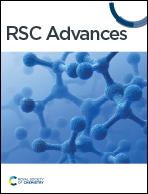Upcycling of sugar refining mud solid waste as a novel adsorbent for removing methylene blue and Congo red from wastewater†
Abstract
The feasibility of utilizing the mud solid waste (MSW) produced during the carbonation process of sugar refining as a cost-effective and environmentally friendly alternative for the water removal of methylene blue (MB) and Congo red (CR), being highly utilized organic dyes representing cationic and anionic species, respectively is presented. Prior to its use, the MSW was dried at 110 °C for 24 h and sieved through a 100-mesh screen. The chief constituent of the MSW utilized was CaCO3, with a point of zero charge (PZC) found at pH 8.4 and 7.96 m2 g−1 total surface area. XRD and FTIR data indicate the presence of interactions between the dyes and the MSW surface, indicating effective adsorption. Different variables, such as initial dye concentration, MSW weight, solution pH, contact time, and temperature, were all examined to determine the optimal dye removal conditions. A central composite design (CCD) approach based on response surface methodology (RSM) modeling was utilized to identify statistically significant parameters for MB and CR adsorption capacities onto the MSW adsorbent. The removal equilibrium was typically reached in 120 minutes, with the greatest removal efficiency of CR taking place at pH 2 and 328 K, while the highest MB removal efficiency was obtained at pH 12 and 296 K. Kinetic studies suggest the adsorption of both dyes on the MSW follow pseudo-second-order rates, as evident through the high correlations obtained. Linearized and non-linearized Langmuir models showed strong correlations indicating maximum adsorption capacities of 86.6 and 72.3 mg g−1 for MB and CR, respectively. High regeneration and reusability potential of the MSW was demonstrated especially for the adsorption of CR, where the removal efficiency was nearly constant throughout five adsorption cycles, ranging from 93 to 91%, while the reduction in the removal for MB was much more significantly impacted, diminishing from 95 to 79% after the five cycles.



 Please wait while we load your content...
Please wait while we load your content...